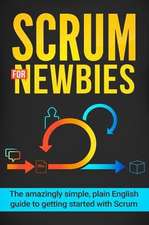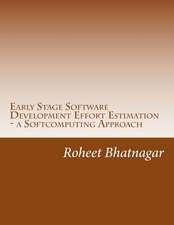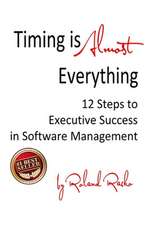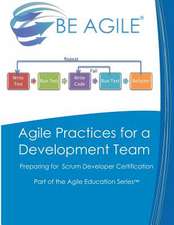Software Craftsmanship: The New Imperative
Autor Pete McBreenen Limba Engleză Paperback – 31 aug 2001
Introducing "software craftsmanship": the programmer-centric way to build great software.
- Putting the "people" back into software development: why "software engineering" isn't enough.
- Transforming the developer's relationship with users and customers.
- Specific steps you can take today -- as a developer or project manager.
Preț: 146.21 lei
Preț vechi: 182.76 lei
-20% Nou
27.98€ • 29.29$ • 23.15£
Carte disponibilă
Livrare economică 15-29 martie
Livrare express 04-08 martie pentru 25.13 lei
Specificații
ISBN-10: 0201733862
Pagini: 208
Dimensiuni: 189 x 232 x 13 mm
Greutate: 0.43 kg
Ediția:1
Editura: Addison-Wesley Professional
Locul publicării:Boston, United States
Descriere
Cuprins
Preface.
I. QUESTIONING SOFTWARE ENGINEERING.
1. Understanding Software Engineering.
The Paradox of Software Engineering.The Modern Definition of Software Engineering.Is Software Engineering a Good Choice for Your Project?2. The Problems with Software Engineering.
Can Software Development Be Made Systematic and Quantified?The Hazards of the Good Enough Software Approach.What Is the Alternative to Software Engineering?3. Understanding Software Development.
Software as Capital.Does the Division of Labor Work for Software Development?One Size Does Not Fit All.4. Finding a Better Metaphor Than Software Engineering.
Finding a Better Metaphor Than Software Engineering.The Craft of Software Development.Parallels with Traditional Craftsmanship.The Resurgence of the Craft of Software Development.II. SOFTWARE CRAFTSMANSHIP.
5. Putting People Back into Software Development.
Craftsmanship Is About Getting Better at Software Development.Craftsmanship Encourages Developers to Write Great Software.A Call to Arms.6. Craftsmanship Is the Opposite of Licensing.
Craftsmanship Is Personal.Licensing Is an Illusion.Craftsmanship Focuses on the Individual.III. IMPLICATIONS OF SOFTWARE CRAFTSMANSHIP.
7. How Craftsmanship Affects the Users of Systems.
Software Craftsmanship Works Because Software Is Easy to Copy.Craftsmen Have a Different Relationship with Their Users.Great Software Deserves to Be Signed.Craftsmen Need Demanding Users.Software Craftsmanship Leads to Collaborative Development.8. Customers Have a Different Relationship with Craftsmen.
Setting Realistic Delivery Dates.Exposing the Fallacy of Good Enough Software.Allowing Software Craftsmen to Take Credit for Their Work.Start Exploiting the Difference in Productivity Between Developers.But How Do We Know How Good a Developer Really Is?Customers Make a Cost/Quality Trade-off When Choosing Craftsmen.Customers Have Long Term Relationships with Software Craftsmen.Customer Interests Are Aligned with the Interests of Software Craftsmen.9. Managing Craftsmen.
Software Craftsmen Are Not Hired Hands.Good Developers Are More Valuable Than Their Managers.Software Craftsmen Have a Different Relationship with Their Managers,Managing Great Developers Is a Pleasure and a Privilege.Software Craftsmen Like Creating Applications.Managing Software Craftsmen Is Different.Software Craftsmen Push for What They Need.10. Becoming a Software Craftsman.
Software Craftsmanship Is a Rejection of Narrow Specialization.Craftsmanship Requires Dedication.How Does a Person Become a Software Craftsman?The Craft Tradition Has Endured for Centuries.11. Mastering the Craft.
What Does a Master Software Craftsman Look Like?Use Your Old-timers.Mastery Implies the Use of Stable Technologies.Developing Mastery Takes Time.Mastery Implies Taking Responsibility for Passing on the Craft.12. Apprentice Developers.
We Must Reverse the Decline in the Quality of Developer Training.Becoming an Apprentice Is a Significant Step.Apprenticeship Instills Lifelong Learning.The Role of Apprentices.An Apprenticeship Is a Significant Investment of Time and Energy.13. Journeymen Developers.
Where Journeymen Fit in the Craft Tradition.Journeymen Developers.Journeymen Are Focused on Delivering Applications.Journeymen Play a Key Role in Software Craftsmanship.IV. REPOSITIONING SOFTWARE ENGINEERING.
14. Software Engineering Projects.
Software Engineering Is Designed for Large Systems Projects.Software Engineering Projects Are Diverse and Varied.15. Hazards of the Software Engineering Metaphor.
You Cannot Do Software Engineering on a Low Budget.Software Engineering Encourages Scientific Management.Software Factories: The Production Line for Software.Reuse over Time Is Hazardous.The Myth of the Standardized Software Development Process.Software Engineering Forces Us to Forget the Individual.We Need More Variety in Our Development Processes, Not Less.16. Learning from Software Engineering.
Size and Complexity Matter.Applications Need to Be Well Structured.Change Can Be Expensive Unless You Allow for It.Communication Inside the Team and with Users Is Crucial.Producing Accurate Estimates Is Very Expensive.V. WHAT TO DO ON MONDAY MORNING.
17. Experience— The Best Indicator of Project Success.
Choose Software Craftsmen Based on Their Reputations.Evaluate Craftsmen Based on Their Reputations and Portfolio.Auditioning a Software Craftsman.Let Your Software Craftsman Pick the Rest of the Development Team.Collaborative Development.Avoid Bleeding-Edge Technology If At All Possible.Paying for Experience.Be Prepared to Be Amazed.Design for Testing and Maintenance.Think Applications, Not Projects.Maintenance Teams Should Refuse to Accept Bad Applications.18. Design for Maintenance.
Software Craftsmen Prefer Nonproprietary, Open Source Tools.Great Software Is Global.Software Craftsmen Need to Fight Back Against Planned Obsolescence.Great Software Needs to Be Given a Great User Interface.Maintainable Software Is Easy to Diagnose.The Hazards of Outsourcing.You Can Still Use Outside Craftsmen to Create Your Application.Maintenance Is the Most Important Part of the Life of Any Application.Not All Software Has to Be Maintainable.Design for Testing and Maintenance Is Not Rocket Science.19. Perpetual Learning.
Creating a Learning Environment.Mastering the Craft of Software Development.Choose Training Courses Very Carefully.Encourage Your People to Be Visible in the Software Development Community.Becoming a Reflective Practitioner.Epilogue.
Acknowledgements.
Index. 0201733862T08072001
Notă biografică
0201733862AB07092002
Textul de pe ultima copertă
By recognizing that software development is not a mechanical task, you can create better applications.
Today's software development projects are often based on the traditional software engineering model, which was created to develop large-scale defense projects. Projects that use this antiquated industrial model tend to take longer, promise more, and deliver less.
As the demand for software has exploded, the software engineering establishment has attempted to adapt to the changing times with short training programs that teach the syntax of coding languages. But writing code is no longer the hard part of development; the hard part is figuring out what to write. This kind of know-how demands a skilled craftsman, not someone who knows only how to pass a certification course.
Software Craftsmanship presents an alternative a craft model that focuses on the people involved in commercial software development. This book illustrates that it is imperative to turn from the technology-for-its-own-sake model to one that is grounded in delivering value to customers. The author, Pete McBreen, presents a method to nurture mastery in the programmer, develop creative collaboration in small developer teams, and enhance communications with the customer. The end result skilled developers who can create, extend, and enhance robust applications.
This book addresses the following topics, among others:
Software Craftsmanship is written for programmers who want to become exceptional at their craft and for the project manager who wants to hire them.
0201733862B07242001"














